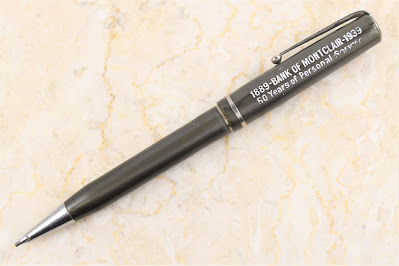This article has been included in The Leadhead's Pencil Blog Volume 7, now available here.
If you don't want the book but you enjoy the article, please consider supporting the Blog project here.
I understood fully why the Krinke auction began the way that it did. The first 114 lots were mostly garden-variety lots of Esterbrook stuff, most of which were individual pieces and nearly all of which were garden variety stuff you’ll see anywhere. Even attaching Krinke provenance to a common Esterbrook pen wasn’t going to increase its value and frankly, if these had all be placed at the end of the auction rather than the beginning, I don’t think anyone would have stuck around for them.
I wasn’t paying much attention as lot after lot of ho-hum Esties sold, chatting away with Eric Magnuson. Advance bids and online bidders were doing all of the buying at first, at prices that were generally full retail, plus a buyers premium. When Brian Anderson finally won something about 30 or 40 lots into the game, it wasn’t anything special but it was the first lot a live bidder was taking home – I clapped a little, and we all chuckled.
I wasn’t completely asleep at the switch, and when lot number 2096 (the 97th lot) came up a couple hours into the bidding, I held up my bidder’s number for the first time after the opening bid was reduced:
These are frequently overlooked for two reasons: first, the difference between these and a “normal” Esterbrook Dollar Pencil in the same series is a subtle one. Here it is, next to its normal cousin:
Instead of the usual marbled grey plastic, this one is flat gray, which leads me to the second reason these don’t get a lot of attention. At some point, Esterbrook used a plain injection-molded plastic on the series, and these were plagued with shrinkage, warping and cracking. Most of the examples look like they’ve been left in the sun too long, or were made for Salvadore Dali, and collectors pass them over due to poor condition:
These four are in reasonably good condition, although the red one has a split in the back of the barrel and none of them work very well, since the caps have shrunk to the point at which they don’t advance the lead very effectively anymore. Still, from an archivist’s perspective, they are part of Esterbrook’s story worth telling.
But where do they fit in? That’s the second reason my bidder’s number went up during the auction, even though I hadn’t previewed it and I was relatively sure it wouldn’t be in working condition:
The Bank of Montclair celebrated 50 years of service with this pencil in 1939. Judging from how poorly these pencils (and the matching pens, too) have fared, I’m assuming this material was withdrawn very soon after it was introduced, so we know that Esterbrook was offering these towards the end of the plastic dollar pencil run, rather than at the beginning.





No comments:
Post a Comment